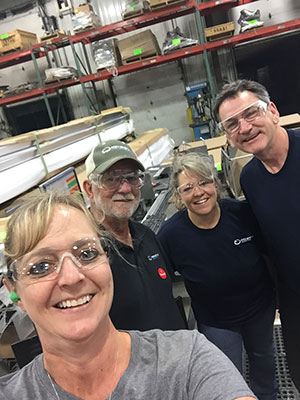Similar to many other manufacturers, Alexandria Industries has long been aware of and affected by the worker shortage. This trend will continue according to market predictions.
The worker shortage was unmistakable recently when we experienced a significant increase in customer requests. Current production workers could not keep up with the mounting work and the pipeline for prospective employees was extremely limited. So we rewrote our playbook and created an alternative game-plan to meet our customers’ needs. It was an extraordinary measure. But one we were more than willing to take.
Our Pregame

Our marketing and sales employees working in production
The shortage of workers isn’t new to anyone. For years, our Alexandria Industries team has spent a great deal of effort to address this issue. In fact, we have written several articles about the steps we are taking to change the misperceptions people may have about working in manufacturing, including the great careers it offers.
Our efforts also have included working with the trade, local, business and national media to share our messages, such as this feature story published in the New York Times.
Well before we had these conversations, however, we began implementing robotics and automation technology to expedite manual labor responsibilities required for machine tending. It may seem like this action would subsequently shrink our workforce. But replacing repetitive tasks with robotics machine tending, gave our operators (and future employees) opportunities to learn other technical skills, such as programming, along with the ability to consider and develop continuous improvement and quality assurance measures. This gave us even more work opportunities versus helping us solve our worker shortage issues.
Game Time
Due to an unscheduled uptick in work early last fall, when production orders were exceeding capacity, we were soon feeling the effect of being a few players short of a full team.
We needed to determine a viable short-term strategy – the right play – to fulfill customer orders. Fortunately, we were able to find resources that already understood the importance of high quality and serving our customers are.
Instead of solely leaving this need in the hands of our production workers who were already working overtime, we asked for more volunteers to work eight hours of overtime a month until we caught up. We extended the offer to every single employee—from the IT department and human resources to sales and marketing.
Before being allowed to work in production, non-production employees trained on job safety, machine tending, and product quality. These employees were then paired with production employees and positioned to work in the same manufacturing cell together.
The Score
Overtime is a business expense most companies try to avoid. We believed, and as it turned out, this alternative solution paid its return on investment in relatively short order.
First, opening up the opportunity to volunteer for overtime to all employees allowed us to get caught up, while not burning out the typical production workers who were already working overtime.
Secondly, office and production employees worked side-by-side, getting to know each other and forming new relationships. Non-production employees gained a better understanding of what their production colleagues do. They also brought a fresh set of eyes to the situation, asking questions about the way things work and identifying production improvements that might not be evident to our production workers who are accustom to doing things a certain way.
A side benefit from this effort found that production employees could share information with their non-production office colleagues about the types of parts they were making, tips on how to be more efficient, and what to watch for in product quality.
In return, a sales rep working on the floor could share information about our relationship with a customer, or maybe some of the challenges our customers face. Information that helps our employees understand what they are working on, for who, and why, opens doors for both process and product improvements.
The extra hands not only allowed us to answer the call to catch up on production, but it also gave us the opportunity to take a different look at our onboarding practices for new employees and make improvements to that as well.
Postgame Report
The new relationships formed between production and non-production employees was an added bonus. It brought us to a new level of working together as one team. Having employees get to know one another and learn how to work together in unchartered territory definitely made a positive impact on our culture. Now when a production employee and an office worker’s paths cross, their greetings feel warmer, friendlier.
Manufacturers may have plans in place to manage a sudden large influx of business. When supplying components for our customers’ products, however, we don’t always know what’s coming next. What matters most is having the inventiveness and flexibility to try new things to solve an old problem. If we are not willing to try something new, we may never get to discover the unique outcomes we never expected.
Besides, whenever there’s an opportunity to form a new relationship, we almost always learn something new about ourselves.
